Garnets are the jewelry stones known to humanity from the ancient times.
The garnet has received Its name from Latin “granatus” - grainy, resembling grains of fruit of grenades. People often consider garnets as only the stone of the red color. In reality the family of garnets consists of the large number of varieties, whose color varies from the colorless to the black. The group of garnets relates to silicates and is divided into 2 subgroups by its chemical composition. There is separated group of iron - magnesia- manganese garnets - pyralspites, named so according to first syllables of the garnets, which enter into this subgroup: this is pyrope (Arizona ruby), almandine, spesartine. Another subgroup is calcium garnets named ugrandites. This is uvarovite, grossularite and andradite. In these subgroups isomorphism is widely developed (ability of some chemical elements to smoothly replace other chemical elements, up to the complete substitution).
Let us examine each of these groups: their color, mining region.
Pyralspites. In this group enter pyrope (Arizona ruby), almandine, spesartine.
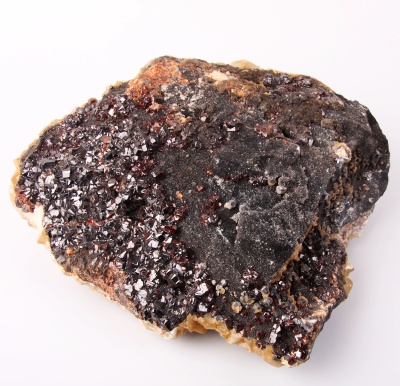 “similar to fire”. This stone in different times was also called other names: carbuncle, and also the Bohemian, Cape, Arizona ruby. Pyrope is the magnesia garnet with chemical formula Mg3Al2(SiO4)3. Pyrope has usually red, reddish- violet, reddish-brown to dark red color. The ions are the basic admixture, which determine pyrope’s color Cr3+ and Fe3+. Pyropes are produced in many deposits: in the Czech Republic (Bohemia), in Tanzania, Republic of South Africa and other African countries, in India, in Sri Lanka, Brazil, Argentina, Australia, Norway, Russia. In other regions they also find the garnets- pyropes with effect of the change of color (alexandrite effect). The color of these stones changes from the bluish-green, the blue in the daylight lightning to the red, reddish-purple in the artificial light, that depends on the admixtures Cr, V and Fe3+.
“similar to fire”. This stone in different times was also called other names: carbuncle, and also the Bohemian, Cape, Arizona ruby. Pyrope is the magnesia garnet with chemical formula Mg3Al2(SiO4)3. Pyrope has usually red, reddish- violet, reddish-brown to dark red color. The ions are the basic admixture, which determine pyrope’s color Cr3+ and Fe3+. Pyropes are produced in many deposits: in the Czech Republic (Bohemia), in Tanzania, Republic of South Africa and other African countries, in India, in Sri Lanka, Brazil, Argentina, Australia, Norway, Russia. In other regions they also find the garnets- pyropes with effect of the change of color (alexandrite effect). The color of these stones changes from the bluish-green, the blue in the daylight lightning to the red, reddish-purple in the artificial light, that depends on the admixtures Cr, V and Fe3+.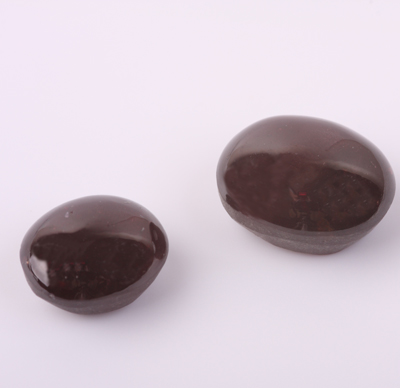 the most common garnet. Its name is connected with the mispronounced name of the locality “Alabanda” in Asia Minor, where these stones were processed in the ancient times. It has also other names - carbuncle (just as pyrope), anthrax, carfunkelstein. Formula of almandine is Fe3Al2(SiO4)3. The color of almandine is connected with ions Fe2+ and Mn2+. It is red, purple-red. Good stones are produced in Sri Lanka, in India, Brazil, in the territory of the USA, in Canada, in Tanzania, Zambia, and in Madagascar.
the most common garnet. Its name is connected with the mispronounced name of the locality “Alabanda” in Asia Minor, where these stones were processed in the ancient times. It has also other names - carbuncle (just as pyrope), anthrax, carfunkelstein. Formula of almandine is Fe3Al2(SiO4)3. The color of almandine is connected with ions Fe2+ and Mn2+. It is red, purple-red. Good stones are produced in Sri Lanka, in India, Brazil, in the territory of the USA, in Canada, in Tanzania, Zambia, and in Madagascar. 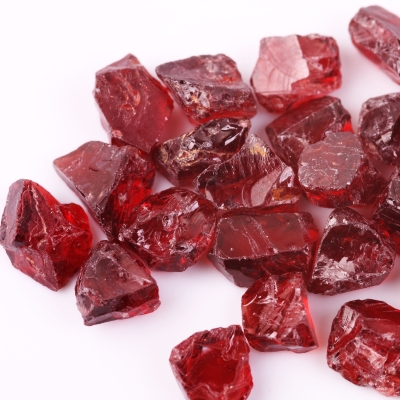
To distinguish pyrope and almandine is visually very complicate, since they, being extreme of the isomorphous line, can be very similar.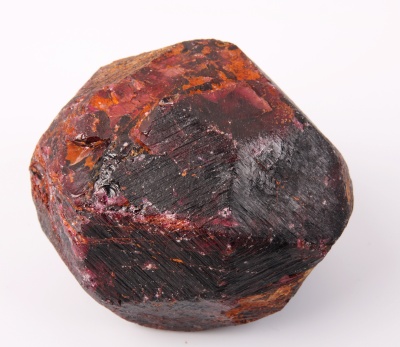 Garnet-rhodolite, which contains in its chemical composition both magnesium and iron, is the intermediate member of this isomorphous line. The color of rhodolite can vary from the purple-pink to the pink. Garnet-rhodolites are produced in Tanzania, Zimbabwe, Sri Lanka and Madagascar.
Garnet-rhodolite, which contains in its chemical composition both magnesium and iron, is the intermediate member of this isomorphous line. The color of rhodolite can vary from the purple-pink to the pink. Garnet-rhodolites are produced in Tanzania, Zimbabwe, Sri Lanka and Madagascar.
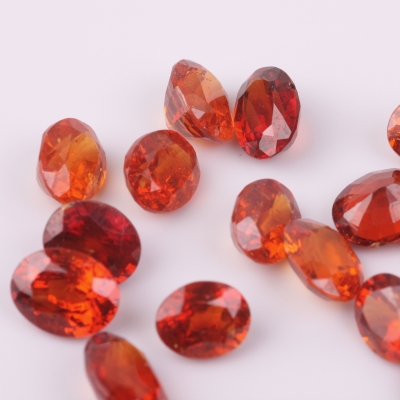 The color of spesartine varies from the yellow-brown through the or
The color of spesartine varies from the yellow-brown through the or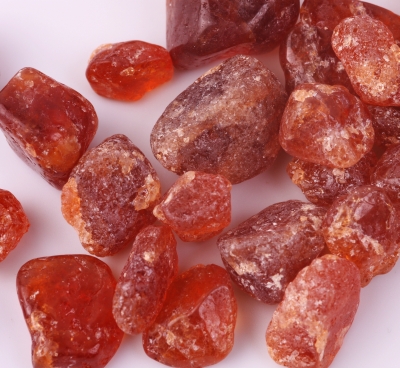 ange to the reddish-orange. The most valuable variety of spesartine is called mandarin – garnet of bright orange color. It is produced in Africa, Madagascar, in Brazil, Sri Lanka, in Mexico and other countries.
ange to the reddish-orange. The most valuable variety of spesartine is called mandarin – garnet of bright orange color. It is produced in Africa, Madagascar, in Brazil, Sri Lanka, in Mexico and other countries. The intermediate component between pyrope and spesartine is the garnet “Malaya” opened in Tanzania in 1979. The color of this garnet is orange-red.
Among garnets from the group of pyralspites we can find rare models with inclusions of the crystals of the rutile, which possess the effect “running strip” - cat eye, and also with the effect of asterism (six and twelve rays).
Ugrandites. The garnets uvarovite, grossularite and andradite enter in this group.
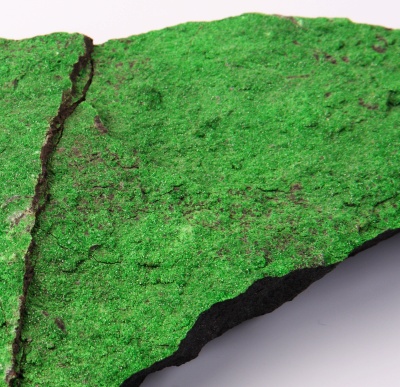 S.S. Uvarov, It was discovered for the first time the middle of 19 century in the Ural. Chemical formula of mineral is Ca3Cr2(SiO4)3. The emerald green color of this garnet is caused by Cr3+. At present it is also discovered in the USA, Canada, Finland, Norway, Republic of South Africa. Unfortunately it is found generally in small forms – crystals of 1-2 mm; the large models with size up to 1 cm are extremely rare. In most cases it is represented on the market in form of brushes.
S.S. Uvarov, It was discovered for the first time the middle of 19 century in the Ural. Chemical formula of mineral is Ca3Cr2(SiO4)3. The emerald green color of this garnet is caused by Cr3+. At present it is also discovered in the USA, Canada, Finland, Norway, Republic of South Africa. Unfortunately it is found generally in small forms – crystals of 1-2 mm; the large models with size up to 1 cm are extremely rare. In most cases it is represented on the market in form of brushes.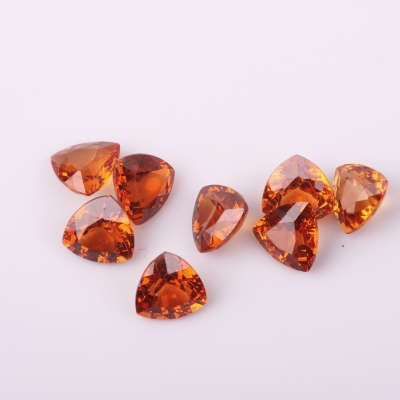 Fe3+ in the yellow-brown and honey-yellow is called hessonite - from the Greek “gesson” means “less, weaker” (this connected with some diagnostic properties of the stone). Colorless grossularite is called “leykogarnet” from the Latin “leyko” – “white”. Leykogarnet is produced in Canada, Mexico, Tanzania. It is also found the rock, which consists of the garnet of grossularite, which is called hydro-grossularite (also known as transwaalsian (African) jade). It was discovered in Republic of South Africa in 1905. It is characterized by the presence of formula in the formula of the water - Ca3Al2(SiO4)2(OH)4.
Fe3+ in the yellow-brown and honey-yellow is called hessonite - from the Greek “gesson” means “less, weaker” (this connected with some diagnostic properties of the stone). Colorless grossularite is called “leykogarnet” from the Latin “leyko” – “white”. Leykogarnet is produced in Canada, Mexico, Tanzania. It is also found the rock, which consists of the garnet of grossularite, which is called hydro-grossularite (also known as transwaalsian (African) jade). It was discovered in Republic of South Africa in 1905. It is characterized by the presence of formula in the formula of the water - Ca3Al2(SiO4)2(OH)4.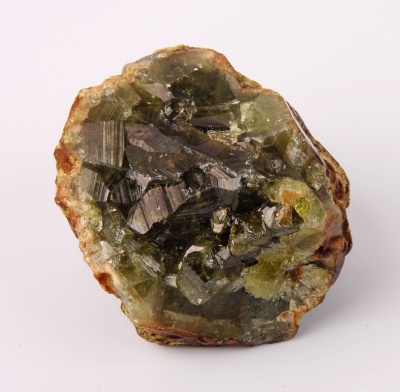 At the present it is produced also in New Zealand, Pakistan and other countries. The color of grossularite can be different according to the content of Fe and Mn. If Fe composes less 2%,
At the present it is produced also in New Zealand, Pakistan and other countries. The color of grossularite can be different according to the content of Fe and Mn. If Fe composes less 2%,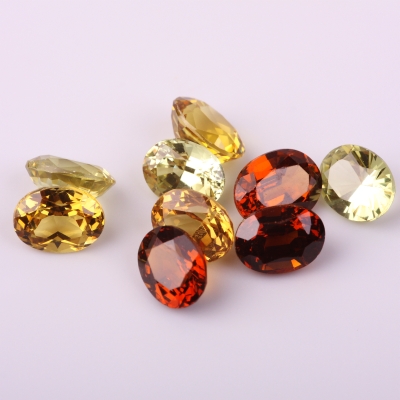 then the stone is colorless or palely colored, and the large quantity of admixture of iron cause the dark green with the yellowish nuances color. Mn causes the pink color of hydro-grossularite (it is found in Mexico). In the hydro-grossularite from Pakistan, and also from some other deposits are noted the admixtures of Cr, which give the green color.
then the stone is colorless or palely colored, and the large quantity of admixture of iron cause the dark green with the yellowish nuances color. Mn causes the pink color of hydro-grossularite (it is found in Mexico). In the hydro-grossularite from Pakistan, and also from some other deposits are noted the admixtures of Cr, which give the green color. 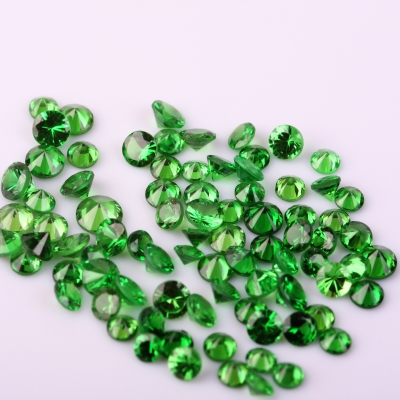 and bright green color is called demantoid - from the Dutch “similar to diamond”, which reflects its strong game and luster in the faceted form. Color of demantoid is caused by presence in its composition of Fe3+ and Cr3+.
and bright green color is called demantoid - from the Dutch “similar to diamond”, which reflects its strong game and luster in the faceted form. Color of demantoid is caused by presence in its composition of Fe3+ and Cr3+.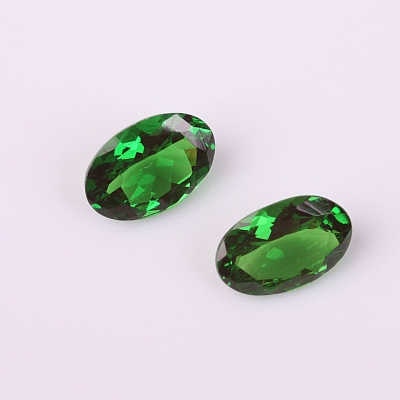 It was found for the first time in 1868 in Ural. Later, in 1874, it was discovered the widely known Ural deposit – Sysertskoe. In our time the demantoids are produced in the deposits of Sri Lanka, in Congo, Zaire, USA. Dimantoid are the most expensive of all garnets (the second on the cost is tsavorite).
It was found for the first time in 1868 in Ural. Later, in 1874, it was discovered the widely known Ural deposit – Sysertskoe. In our time the demantoids are produced in the deposits of Sri Lanka, in Congo, Zaire, USA. Dimantoid are the most expensive of all garnets (the second on the cost is tsavorite). The andradite of black color is called melanite, from the Greek. “Melas” - black. The color of melanite is caused by the admixture of titanium. Can be found in Germany, USA, Russia and some other countries.